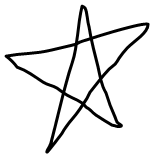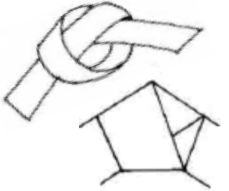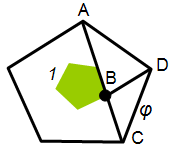Storytelling Science
Five-Sided Stories
Amitabha Mukerjee
These stories are best enjoyed if you follow along! So get a pen and start scribbling on this very newspaper.
Story 1: Star Wars
Draw a five-point star - it's easy because it can be drawn in five fluid strokes without lifting the pen. Inside and outside this star are two pentagons.This star shape was a magical icon for Greeks like Pythagoras. Later, it became associated with the crescent in Islam - e.g. you can see it on the flag of Pakistan. Some say this is because there was a conjunction of the crescent moon and Venus in the dawn sky of July 23, 610, when Muhammad may have received his revelation.
While Islam has a five pointed star, Jews have the six-sided David's Star as their symbol. Now look at this asterisk: * - can you make out that it has five points? Some say that typefaces with six-sided asterisks were rejected by Arabs since the six-sided "David's Star" is a Jewish symbol and appears on theirflag. That's real "star wars" for you.


Draw this five-pointed star. A version of it appears on the Flag of Pakistan.
Story 2: Starry apples
Cut an apple transversely. You will find five tips in a star shape - these are its five seeds. Many flowers have their petals growing in fives - this may be because five appears in the Fibonacci series, where any number is the sum of the two previous ones: 1,1,2,3,5,8,13,21,34,55,89,... For example, a banana, cut the same way, has three parts; a sunflower has 55 spirals one way, and 89 the other! Some people think that this happens because the next thing growing wants the most space, and space gets distributed inversely as these numbers.Remember "Fibonacci numbers", we'll come back to them. But before I go on, don't take my word for it - go cut that apple; sometimes you find six-star apples - may be they are from Israel?
Story 3: Presto Pentagon
A regular pentagon has five equal sides at angles of 108 degrees. Drawing a pentagon with straightedge and compass is an advanced exercise in geometry [Try it]. Far easier is this mehod, which I learnt from "Ten Little Fingers" by Arvind Gupta (National Book Trust, Rs. 60). Tear a straight strip along the vertical margin of this news paper (2-3 cm wide). Why is it harder to tear horizontally? Make a knot and flatten it. Tear off the protruding strips to finish your pentagon!


Take a strip of paper and tie it into a knot. Tighten the openings and flatten it - voila! Your 30 second pentagon! Where two diagonals meet (point B) is a Golden Section division.
Story 4: The Golden Section
Now that you have a pentagon, (You do have a pentagon, don't you? Just cut or tear a neat strip from this paper and knot it up!) Now fold your pentagon along all the diagonals (e.g. AC is a diagonal). Can you see the smaller pentagon inside it? The point B where two diagonals intersect divides AC in the same ratio as the big pentagon to the small one. In fact, AC/AB = AB/BC = big-pentagon/small = (1+√5)/2 = 1.618... This number is written φ and called the Golden Section. It has the property that 1 + 1/φ = φ .
Story 5: Calculator Calisthenics
The symmetry in this shape led the Pythagoreans to call it "hygieia", Goddess of Health. They thought it has magical properties, and it is really magical in many ways. Here's one, but it needs a calculator. Switch it on and press these keys in sequence, repeatedly: "+" "1" "=" "1/x". After each "=" you should get: 1, 2, 1.5, 1.67, 1.6, 1.625, 1.615, 1.619 - if you keep doing it, you will gradually converge towards 1.618033..., the exact value of the golden section! Actually, what is happening is that this series computes the ratios of two numbers from the series: 1,1,2,3,5,8 -- looks familiar? Yes, we are back to the Fibonacci series from story 2!That's enough magic for now, but I have kept some more five-sided stories on the web resources page: http://www.cse.iitk.ac.in/~amit/story/. After you are done yourself, sit with some kids. Once they work through the stories with their scissors and their minds, they will remember what they learn forever!